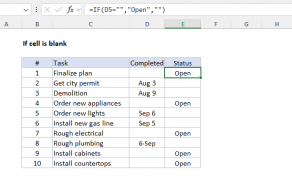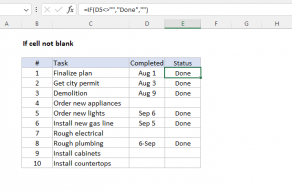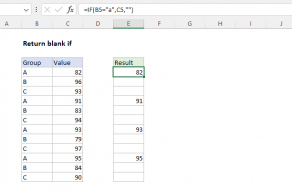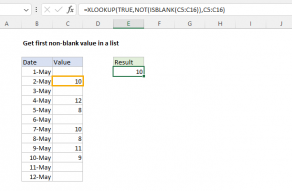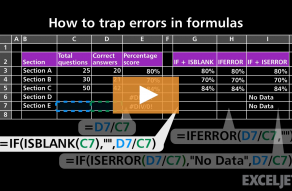Purpose
Return value
Syntax
=ISBLANK(value)- value - The value to check.
Using the ISBLANK function
The ISBLANK function is a simple function to test if a cell is empty or not. If a cell is empty, ISBLANK returns TRUE. If a cell contains any value, ISBLANK returns FALSE. ISBLANK function takes one argument, value, which is a cell reference like A1. For example, if cell A1 contains nothing at all, the ISBLANK function will return TRUE:
=ISBLANK(A1) // returns TRUE
If cell A1 contains any value or any formula, the ISBLANK function will return FALSE:
=ISBLANK(A1) // returns false
The word "blank" is ambiguous in Excel, because a cell that contains only a space character will look blank but not be empty. It is best to think of ISBLANK to mean "is empty" since it will return FALSE when a cell looks blank but is not empty.
Things to know about the ISBLANK function
Here are some things you should know about the ISBLANK function:
- You can use ISBLANK to test for empty cells in a dataset.
- You can use the ISBLANK function to trigger a Conditional Formatting rule that highlights all empty cells (see below).
- You can combine ISBLANK with the IF function to display a custom message if a cell is empty. For example, you might display "Input Required" if a cell is blank.
- You can use ISBLANK to stop a formula from calculating when certain cells are empty. For details, see this example.
- You can combine ISBLANK with the NOT function to reverse the logic to "is not blank" (see below).
- Instead of =ISBLANK(A1), you can use the syntax A1="". See below for details.
- If you want to count blank cells see the COUNTBLANK function.
Example - test if cells are empty
In the worksheet below, the ISBLANK function is used to test if cells in column B are empty. The formula in cell C5 is:
=ISBLANK(B5)

As the formula is copied down, it returns TRUE if the corresponding cell in column B is empty and FALSE if not. Notice the result in cell C8 is FALSE even though cell B8 looks empty. However, because cell B8 contains a single space, it is not empty.
Example - Is not empty
To reverse the logic and test for cells that are not blank (not empty) you can nest ISBLANK inside the NOT function like this:
=NOT(ISBLANK(A1)) // test not blank
You can see this approach in the worksheet below. The formula in cell C5 is:
=NOT(ISBLANK(B5))

The above formula will return TRUE when a cell is not empty, and FALSE when a cell is empty. Notice this exactly reverses the results seen with ISBLANK alone.
Example - If a date is blank
A classic example of the ISBLANK function is to test if a cell is empty and display a custom message if so. The worksheet below contains a list of tasks in column C. In column D, a date is present if a task is complete. In column E, the ISBLANK function is used together with the IF function to mark tasks that do not have a date as "Open". The formula in cell E5, copied down, is:
=IF(ISBLANK(D5),"Open","")
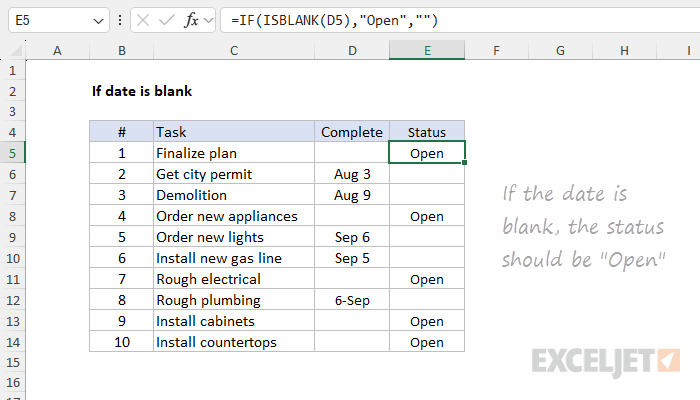
You can easily extend this formula to mark tasks that do have a date as "Closed" like this:
=IF(ISBLANK(D5),"Open","Closed")
Example - highlight blank cells
You can use the ISBLANK function to quickly highlight empty cells with Conditional Formatting. In the worksheet below, the formula used to highlight blank cells is:
=ISBLANK(C5)
When ISBLANK returns TRUE, it triggers a Conditional Formatting rule that applies a bright fill color to empty cells in the range C5:J16. This makes it easy to see at a glance which students are missing quiz scores:

The formatting is dynamic — if the data changes, the highlighting will automatically update as required. For step-by-step instructions, see this example.
ISBLANK alternative syntax
Many formulas will use an abbreviated syntax to test for empty cells, instead of the ISBLANK function. This syntax uses an empty string ("") with Excel's math operators "=" or "<>". For example, to test if A1 is empty, you can use:
=A1="" // TRUE if A1 is empty
To test if A1 is not empty:
=A1<>"" // TRUE if A1 is not empty
This syntax can be used interchangeably with ISBLANK. For example, inside the IF function:
=IF(ISBLANK(A1),result1,result2) // if A1 is empty
is equivalent to:
=IF(A1="",result1,result2) // if A1 is empty
Likewise, the formula:
=IF(NOT(ISBLANK(A1)),result1,result2)
is the same, as:
=IF(A1<>"",result1,result2)
Both will return result1 when A1 is not empty and result2 when A1 is empty.
Handling empty strings returned by formulas
If a cell contains any formula, the ISBLANK function and the alternatives above will return FALSE, even if the formula returns an empty string (""). This can cause problems when the goal is to count or process blank cells that include empty strings. One workaround is to use the LEN function to test for a length of zero. For example, the formula below will return TRUE if A1 is empty or contains a formula that returns an empty string:
=LEN(A1)=0 // TRUE if empty
So, inside the IF function, you can use LEN like this:
=IF(LEN(A1)=0,result1,result2) // if A1 is empty
You can use this same approach to count cells that are not blank.



